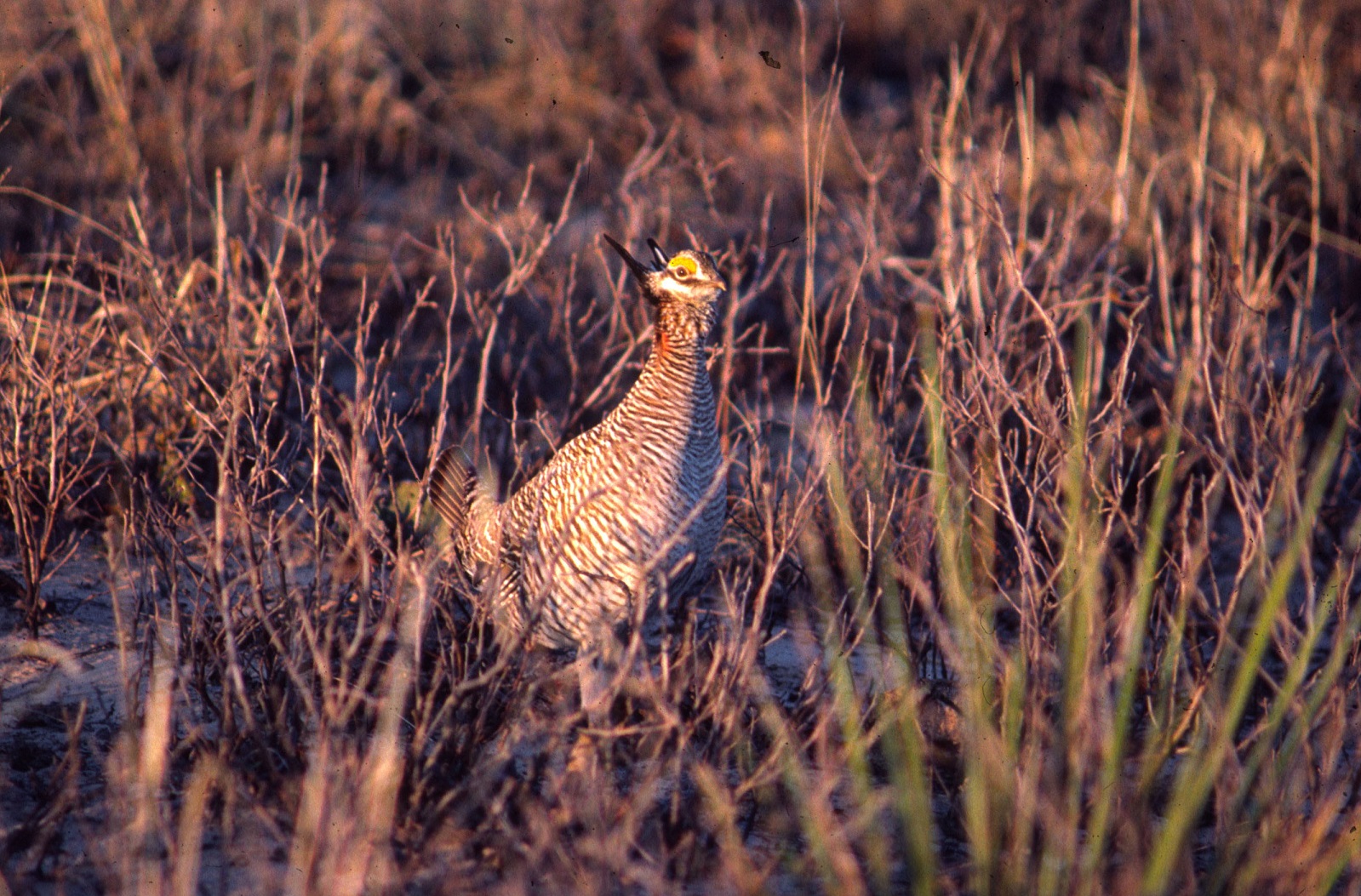Lesser Prairie-Chicken Response to USDA Conservation Practices in Kansas and Colorado

Dr. Beth Ross, postdoctoral research associate
Project Supervisors:
Dr. David Haukos
Funding:
USDA NRCS
USDA FSA
Cooperators:
Dr. Christian Hagen
Jim Pitman
Dr. David Dahlgren
Kansas Department of Wildlife, Parks, and Tourism
Location:
Throughout Kansas and eastern Colorado
Completion:
March 2016
Status:
Completed
Objectives:
Quantify the relative importance of changes in CRP and climate on LEPC abundance and demographic parameters.
Quantify the spatial extent, juxtaposition, and habitat composition/structure of CRP grasslands and native prairie habitat that yield high likelihood of LEPC occurrence.
Link abundance of the "best" landscapes to fitness parameters for populations.
Examine abundance and population demographics to quantify the relative values of various management strategies for CRP and other USDA conservation programs.
Progress and Results:
Significant numbers of lesser prairie-chickens of Kansas and Colorado are associated with former croplands that have been enrolled in a U.S. Department of Agriculture conservation programs/practices, principally the Conservation Reserve Program (CRP) and Environmental Quality Incentive Program (EQIP). At a broad-scale CRP has reduced habitat fragmentation and assisted in connecting extant and expanding populations. Additionally, conservation practices with CRP fields that may be affecting these populations include vegetation species composition, development of supplemental water areas, mid-term management practices, and emergency haying/grazing declarations. Use of CRP may also be related to juxtaposition of CRP, cropland, and other land uses. In addition, the overall population response by lesser prairie-chickens to conservation programs needs to be assessed in regard to demography of the population to model future population trends. Concurrent with CRP and land use practices, more information is needed on the response of lesser prairie-chickens to changes in climate. The Great Plains region is predicted to experience increasing drought conditions, which could negatively affect lesser prairie-chickens in the future. A better understanding of the interaction between land use and climate change on lesser prairie-chicken population demographics is important for future management practices. Our results thus far indicate that extreme values of Palmer Drought Severity Index (both low and high, or dry and wet conditions) during the spring breeding season were the best predictors of changes in lesser prairie-chicken abundance, though neither had a significant effect on male lesser prairie-chicken abundance on leks. Abundance on leks was highest during the mid-1980s, followed by low population abundance in the 1990s. The population has remained relatively stable since the late 1990s. Additionally, increasing the ratio of cropland to grassland in a given area (i.e., moving towards more cropland) reduces the resilience of lesser prairie-chickens to extreme drought conditions. Using an integrated population model, we found that juvenile survival is likely most impacted by extreme drought causing the shifts in population abundance that are observed.
Products:
Publications:
Ross, B.E., D. Haukos, C. Hagen, and J. Pitman. 2016. The relative contribution of climate to changes in lesser prairie-chicken abundance. Ecosphere 7(6).
Ross, B.E., D. Haukos, C. Hagen, and J. Pitman. 2016. Landscape composition creates a threshold influencing Lesser Prairie-Chicken population resilience to extreme drought. Global Ecology and Conservation 6:179-188.
Professional Presentations:
Godar, A. J., C. P. Griffin, B. A. Grisham, D. A. Haukos, S. R. Fritts, B. E. Ross, C. W. Boal, C. A. Hagen, M. A. Patten and J. C. Pitman. 2017. Combining Weather Data and Climate Projections: A Case Study with Lesser Prairie-Chickens. Midwest Fish and Wildlife Conference, Lincoln, NE.
Ross, B., D. Haukos, C. Hagen, and J. Pitman. 2016. Combining multiple data sources to determine drought and land-use impacts on lesser prairie-chickens. North American Ornithological Congress, Washington, D.C.
Ross, B. E., D. A. Haukos and P. Walther. 2016. Drivers of Mottled Duck Pairs on the Upper Texas Gulf Coast. North American Duck Symposium, Annapolis, MD.
Ross, B., D. Haukos, C. Hagen, and J. Pitman. 2015. The relative influence of climate variability and landscape change on lesser prairie-chicken populations. Annual Meeting of The Wildlife Society, Winnipeg, Manitoba.
Ross, B.E. Quantifying drivers of wildlife population dynamics. July 2015. Early Career Researcher Symposium. American Ornithologists' Union. Norman, Oklahoma.
Ross, B., D. Haukos, C. Hagen, and J. Pitman. 2015. Combining multiple data sources to determine drought and land-use impacts on lesser prairie-chickens. Joint meeting of American Ornithologists' Union and Cooper Ornithological Society, Norman, OK.
Ross, B., D. Haukos, C. Hagen, and J. Pitman. 2015. Extreme drought events and changes in land cover interact to reduce resilience of the lesser prairie-chicken. Annual meeting of the Central Mountains and Plains Section of The Wildlife Society, Manhattan, Kansas.
Ross, B.E., D. Haukos, C. Hagen, and J. Pitman. 2014. Changes of Lesser Prairie-Chicken Abundance in Kansas. Midwest Fish and Wildlife Conference, Kansas City, MO.
Ross, B.E., D. Haukos, C. Hagen, and J. Pitman. 2014. Changes of Lesser Prairie-Chicken Abundance in Kansas. Kansas Natural Resources Conference, Wichita, KS.
Ross, B., D. Haukos, C. Hagen, and J. Pitman. 2014. The relative influence of drought and habitat on lesser prairie-chickens. Society for Conservation Biology, Missoula, Montana.
Ross, B., D. Haukos, C. Hagen, and J. Pitman. 2014. Combining multiple data sources to determine climate and land-use impacts on lesser prairie-chickens. Annual Meeting of The Wildlife Society, Pittsburgh, PA.